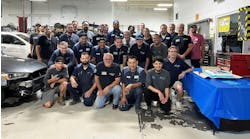Years ago, when carmakers needed to reduce the weight of their vehicles, they naturally turned to plastic. Its light weight and flexibility appealed to automotive engineers, who soon began employing plastic in bumper covers, fascia, body side moldings, filler panels, extension panels, valance panels and spoilers.
While gladdening the hearts of automotive engineers, plastic parts have caused heartburn for many refinishers. In part, it’s due to the variety of plastics used in automobiles—TPO, ABS, RIM, RRIM, PUR, SMC, PVC, PE, to mention a few (see sidebar, “By the letters” for explanations of the abbreviations).
Fortunately, plastics can generally be broken down into two categories: thermoplastics and thermosets. Thermoplastics are moldable and can be deformed by heat, so they can be recycled. They are also sensitive to solvent attack. This group includes ABS (acrylonitrile butadiene styrene) and polyolefins like polypropylene and TPO (thermoplastic olefin). Thermosets are insoluble and infusible, making them difficult to recycle. Typical thermosets are non-polyolefins, including polyurethanes (PUR, RIM, RRIM) and SMC.
In order to choose the correct refinishing system, the refinisher needs to identify the plastic type. The simplest method is to check the identification symbol (ISO code) imprinted on the back of the part. Of course, this isn’t feasible if the part is on the vehicle. What’s more, an ISO code is not required, so there are a few parts that will not have a code. In these cases, you can use the float or abrasion test (See sidebar, “Testing the plastic”). I-CAR no longer recommends the burn test because of fumes.
The bad news, however, according to I-CAR, is that none of these tests is foolproof. But there is also good news: 1) TPO is the most common plastic used today, so that reduces the identification process, and 2) if all else fails, all you really need to know for refinishing is whether the plastic is a polyolefin, particularly because polyolefins require an adhesion promoter.
Panel, Not Spot Repair
Refinishing interiorplastic parts
With a few notable exceptions, refinishing interior plastic parts is similar to refinishing exterior plastic parts. Once again, the plastic must be identified and cleaned thoroughly. Parts with grained or pebbled surfaces are especially difficult to clean because dirt and mold can become trapped deep in the surface. In these cases it’s often easiest to start with a new part.
The exceptions mentioned above are primarily due to a federal regulation that applies to all components in a driver’s vision: They must be painted with a low-gloss or flat finish to prevent sun glare or sun reflection into the driver’s eyes. The following parts are affected:
1. Instrument panel upper section cover
2. Instrument panel at front of cover
3. Radio front speaker grilles
4. Windshield pillars and other parts at the front end
In addition, although the parts listed below are not in the driver’s vision, the same principle applies because they can reflect sunlight off the rearview mirror.
1. Back window side and lower finishing moldings
2. Radio speaker grilles
3. Rear window defogger grilles
4. Rear package shelf trim foundations
All other interior painted parts are usually painted with a semi-gloss finish, which is about a 25- or 30-degree gloss, unless otherwise specified. Interior semi-gloss parts are:
1. Door, headlining and side wall trim, including attached
parts
2. Arm rests
3. Seat cushions and seat backs, including attached parts
4. Heat rests
5. Station wagon, SUV and hatchback rear load floors
Matching the gloss on repaired interior parts to adjacent trim parts, it may be necessary to use a gloss flattening compound. These are available in two types —one for urethane finishes and another for non-urethane finishes. Follow this procedure for gloss-flattening compounds:
1. Prepare the compound according to the label directions by agitating it thoroughly.
2. After color-coating the part and determining that flattening compound is required, add the compound in small amounts, such as 5 percent at a time, to the reduced color and stir thoroughly.
3. Spray out a small sample panel and allow it to dry for several minutes. Check for the proper gloss level with adjacent parts. Adjust the color with additional flattening compound as required.
4. Apply the final one or two color coats to the part as required.
Caution: Some paint materials can accept only a certain amount of flattening agent. After that, the paint loses its durability. Check the label, the paint manufacturer or your jobber for further information.
One final caution: Do not refinish air bag covers. This could cause airborne paint chips when the bag deploys, or modify timing of bag deployment.
Be prepared to do a panel repair. In general, spot repairs are difficult to make on plastic parts. It’s usually necessary to refinish an entire panel or refinish to a well-defined break line.
Most plastic repairs involve fascia–bumpers and front end panels—and they present several potential problems. In addition to their flexibility, there is the possible incompatibility of the substrate (TPO) and the coating and the potential for poor wetting of the coating. So selection of the finishing system becomes critical.
The key properties of a coating used on flexible plastic parts are adhesion, impact resistance and flexibility. These film properties are closely related and if any one of them is compromised during preparation or application, trouble—in the form of a re-do or comeback—is likely to result. Each of the major paint manufacturers offers a system for painting every type of plastic surface. It’s important to follow the paint manufacturer’s recommended steps because plastic requires more attention and care than sheet metal or steel. And, as with most refinish repairs, paint system manufacturers recommend you stick to only one product system throughout the refinishing process.
Surface Preparation
When repairing plastic, there are many pitfalls to avoid—e.g., careless surface preparation, forgetting an additive, failing to allow sufficient dry time. But let’s start with the basis for any good paint repair: surface preparation.
No matter which brand of paint you use, surface preparation is all-important—even more so than when working with metal. Begin by washing with a pH-neutral soap and hot water solution (avoid dish detergent because of the lanolin additives) to remove water soluble contaminants. Follow that with a cleaning solvent to remove solvent soluble surface contaminants. These wash steps are essential to producing a thoroughly clean surface, which is key to good adhesion of the repair finish. Most experts agree that the two major reasons for plastic repair failures are incorrectly identifying the plastic and not cleaning the surface correctly.
Thorough sanding is also essential to promoting good adhesion. Avoid using coarse grits on flexible plastic parts. To be safe, use 800- to 1000-grit paper. Too many shops use 320-grit paper, which may damage the plastic surface.
Follow the sanding step with a solvent wipe to remove sanding sludge and any mold release agents exposed by sanding.
Solvent Test
Before applying undercoats, I-CAR recommends a solvent test to identify sensitive substrates. The solvent test consists of the following steps:
-Wet a cloth with a strong, slow solvent.
-Hold the cloth on a featheredged area for 30 to 60 seconds. On a new part, hold the cloth on a primed area. Avoid contact with bare plastic to prevent solvent absorption.
-Check the cloth for material transfer.
-Check the substrate layers for softness.
-If there is material transfer or the substrates are soft, correct the condition according to recommendations from the paint, vehicle or part makers.
-If the substrates are sound, apply undercoats. On a new part, scuff-sand the entire part before applying undercoats.
Applying Undercoats
Next, apply the proper primer, following the paint maker’s recommendations. A flex additive or a plastic adhesion promoting primer or sealer is often required. When properly used, coatings containing flexible additives will increase the flexibility and durability of the repaired plastic upon exposure. Adhesive promoters contain aggressive solvents that “open up” the plastic surface and allow the finishing system to get a strong hold. Recommendations that re-balance the mix ratios of clear coats to incorporate the flex add into the curing process enable the flex add to remain in the system longer, becoming part of the film network. This leads to films that remain softer longer and maintain flexibility on exposure—the keys to withstanding damage during light impact.
According to I-CAR, adding a flex additive is another step that is often overlooked. Perhaps “overlooked” isn’t the right word. “Ignored” may be more on target, and it applies to shops that think they are saving time by skipping this step. Again, doing so will almost always lead to paint failure and, most likely, a re-do.
Next, reprime if more surface leveling is necessary. Then sand the repair area and prepare the blend areas, following manufacturer’s recommendations.
Finally, proceed with the finish application, being careful to remove all contaminated masking materials before applying final topcoats. (Note: for optimum chip and adhesion performance, you must use an activated base coat.)
Preparing a New Part
The recommendations for working with a new part are the same as working with a repaired part, with one exception: Some paint or vehicle makers recommend baking unprimed plastic to force the mold release agent to the surface. You can do this by placing the part in the spray booth during the bake cycle. Be careful, however, to adequately support the part. Thermoplastics soften and tend to lose their shape when heated. After the part has cooled down, follow the cleaning procedures outlined above.
If the part is primed, perform a solvent test and proceed as outlined above.
Recycled (Salvage) Parts
Before preparing a salvage part, inspect it for surface defects, unsound paint film, excessive film thickness (more than 10 mm), stress cracks and improper previous repairs or refinishing. Then identify the plastic and proceed with the appropriate finishing system.



